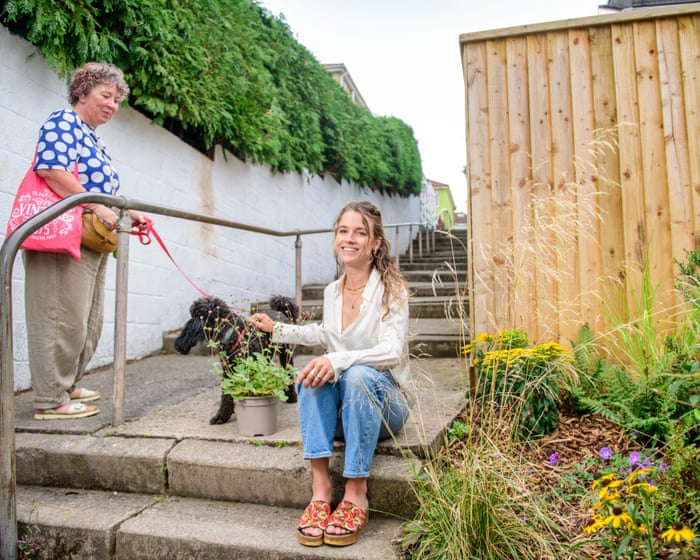Tag et nærmere kig på de farverige planter, der gror langs en engang ubemærkelsesværdig gyde i Bristol, og du vil opdage, at de myldrer med insekter. Humlebier, svirrefluer og mariehøns samles om en blanding af katteurt, røllike, storkenæb og anemone. "Det summer nu af pollinatorer," siger Flora Beverley.
For lidt over et år siden var denne gyde en kedelig, tilstoppet losseplads. Nu er den takket være pollinatorvejs-projektet fyldt med nektarrige planter og bihoteller. Farverige malerier pryder væggene. En nabo og hendes søn standser for at fortælle Beverley, at de vandede planterne i går. Lokale beboere, der hjalp med at forvandle gaderne, vedligeholder dem fortsat.
Beverley, en trail-løber og fitness-influencer, startede projektet, efter en kronisk sygdom begrænsede hendes tid til at løbe på landet. Hun ønskede at bringe mere natur ind i sit lokalsamfund og hjælpe med at forbinde vigtige nærliggende habitater i Bristol, såsom parker og Northern Slopes naturreservat, med insektvenlige korridorer.
Projektet tog uventet godt fart. På blot et år har lokale grupper fornyet syg gader i byens sydlige del. De fleste transformationer foregår over en weekend, hvor frivillige og muralkunstnere hjælper til. Finansieringen kommer fra små tilskud, som Beverley ansøger om i sin fritid – hun bliver ikke betalt – samt indsamlinger på gaden og donationer fra lokale virksomheder.
"Det, der er godt for naturen, har tendens til også at være godt for mennesker," siger hun. "Vi er heldige at have så mange grønne områder i Bristol, men de er ikke godt forbundne. Habitatfragmentering er et stort problem."
Forskere rapporterer katastrofale fald i insektbestande verden over. Internationale oversigter estimerer årlige tab på 1% til 2,5% af den samlede insektbiomasse. Årsagerne varierer, men omfatter tab af levesteder, pesticidudsaettelse og klimakrisen. I Storbritannien viste en citizen science-undersøgelse fra Buglife, der registrerer insektpletter på biler, et fald på 63% i flyvende insekter mellem 2021 og 2024.
Der er mange måder at hjælpe med at beskytte insekter på, nogle enkle, andre mere udfordrende. Prof. Dave Goulson fra University of Sussex siger, at skabelse af mere pollinatorvenlige habitater i byer er "en ret nem sejr."
"Vi ved allerede, at byområder kan være overraskende gode for pollinatorer sammenlignet med moderne, intensivt landbrugsjord," siger han. "Hvis vi grønnegør haver, parker, vejkanter, rundkørsler, kirkegårde og små gader i Bristol, løber det hele op. Der er ingen ulemper ved at have vilde blomster i vores byer. Ud over at hjælpe biodiversiteten, forbinder det mennesker med naturen. Børn kan vokse op omgivet af humlebier, sommerfugle og fuglesang."
Bristol-gadeprojektet er en lokal indsats, men det er en del af en voksende global bevægelse. Udtrykket "pollinatorvej" blev opfundet i 2007 af den amerikanske kunstner Sarah Bergmann til sit projekt, der forbinder Seattle Universitys campus med Nora's Woods med en korridor af indfødte planter.
Siden da er et stort netværk af fællesskabs-pollinatorveje opstået i 300 byer i 24 amerikanske stater og i Ontario, Canada. Det startede i 2017, da naturbeskytteren Donna Merrill tilbød gratis indfødte træer til folk nær sin hjemby Wilton, hvilket skabte et pollinatorhabitat, der krydsede grænsen mellem Connecticut og New York. Merrill var inspireret af Oslos "bivej," et netværk af grønne tage, bikube og insektvenlige planter, der spænder hele byen.
I Storbritannien adresserer Buglife tabet af pollinatorhabitat på nationalt gennem... Gennem sit B-Lines-netværk kortlægger Buglife en række 3 km brede insektsupermotorveje, der krydser Storbritannien og forbinder de bedste tilbageværende områder rige på vilde blomster. I over et årti har velgørenheden samarbejdet med landmænd, grundejere, dyrelivsorganisationer, virksomheder, lokale myndigheder og offentligheden for at sikre, at mindst 10% af hver rute er beplantet med insektvenlige blomster.
B-Lines har allerede hjulpet arter som blåbær-humlebien i Shropshire og den lille skabiose-minerbi i det sydvestlige England med at udvide deres populationer. Buglife opfordrer pollinatorprojekter til at markere deres indsats på et online kort over disse insektmotorveje, hvor over 3.800 initiativer allerede er indtegnet.
Rachel Richards, velgørenhedens B-Lines-koordinator, bemærker, at nord-syd-ruterne er særligt vitale for migrerende arter og dem, der bevæger sig nordpå på grund af klimaændringer. "Genoprettelse af fragmenterede landskaber bygger modstandsdygtighed," forklarer hun. "Med flere brande og oversvømmelser kan selv vigtige steder blive beskadiget. Men hvis vi har brosten af vildblomsthabitat, kan insekterne genkolonisere fra nærliggende områder."
I Bristol sigter Beverley mod at udvide sit pollinatorvejsprojekt og gøre det bæredygtigt. I forventning om varmere, tørrere somre har hun inkluderet hårdføre, tørketolerante planter i gaderne. Ukrudt, der kan blokere adgang, fjernes manuelt for at undgå, at kommunen bruger herbicider.
Efter hendes videoer på de sociale medier af de transformerede gader har opnået hundredtusindvis af visninger, planlægger hun at skabe en skabelon for andre til at replikere uden for Bristol. I mellemtiden er lokale beboere ivrige efter at vedligeholde pladserne. "Alt affald bliver hurtigt ryddet op, fordi folk erkender, at det er et særligt sted, vi ønsker at bevare," siger Beverley. "Det er en bifrokkost, og nu ankommer pollinatorer i stort antal."
Ofte stillede spørgsmål
Ofte stillede spørgsmål om bifrokkoster
Hvad er en bifrokkost?
En bifrokkost er en have eller et grønt område fyldt med planter, der giver mad og levested for pollinatorer som bier, sommerfugle og andre insekter.
Hvad er pollinatorveje?
Pollinatorveje er forbundne korridorer af pollinatorvenlige habitater, ofte skabt i bymæssige eller forsømte områder som gader, for at hjælpe insekter med at bevæge sig sikkert og finde ressourcer.
Hvorfor er bifrokkoster og pollinatorveje vigtige?
De støtter faldende pollinatorbestande, øger den lokale biodiversitet, forbedrer bestøvning af haver og afgrøder og gør byrum grønnere og smukkere.
Kan jeg skabe en bifrokkost på et lille område som en altan?
Ja. Selv få potter med pollinatorvenlige blomster som lavendel, gåseurter eller salvie kan give værdifuld mad for bier og andre insekter.
Hvilke planter er bedst til en bifrokkost?
Vælg indfødte blomstrende planter som solsikker, solhat, bibernelle, kløver og urter som timian eller mynte. Undgå pesticider.
Tiltrækker bifrokkoster uønskede insekter eller skadedyr?
De tiltrækker primært pollinatorer, som er gavnlige. Korrekt plantevalg og vedligeholdelse kan minimere uønskede skadedyr.
Hvordan hjælper bifrokkoster miljøet?
De støtter økosystemets sundhed ved at fremme bestøvning, øge plantediversitet, binde kulstof og reducere byvarme.
Er bifrokkoster sikre omkring børn eller kæledyr?
Ja, hvis der bruges ikke-giftige planter og der tages hensyn til at undgå planter, der kan forårsage allergier. De fleste pollinatorer er ikke aggressive, hvis de ikke forstyrres.
Kan jeg skabe en pollinatorvej i mit nabolag?
Absolut. Start med at plante pollinatorvenlige planter i din have eller fællesområde og opfordre naboer til at gøre det samme for at skabe forbundne habitater.
Hvad er almindelige udfordringer ved at starte en bifrokkost?
Mangel på plads, dårlig jord, begrænset sollys eller valg af ikke-indfødte planter. Start i det små, brug containere hvis nødvendigt, og vælg hårdføre, indfødte arter.
Hvordan vedligeholder jeg en bifrokkost?
Vand planter regelmæssigt, undgå pesticider, fjern visnede blomster for at fremme blomstring, og lad noget bart jord eller redeematerialer tilbage for solitære bier.
Kræver bifrokkoster meget vand?
Ikke nødvendigvis – mange pollinatorvenlige planter er tørketolerante. Brug af mulch og valg af indfødte arter kan reducere vandbehovet.




